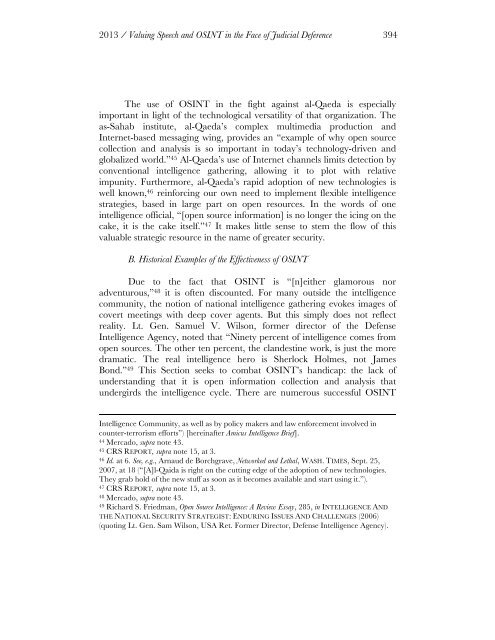Vo.4-Moshirnia-Final
Vo.4-Moshirnia-Final
Vo.4-Moshirnia-Final
You also want an ePaper? Increase the reach of your titles
YUMPU automatically turns print PDFs into web optimized ePapers that Google loves.
2013 / Valuing Speech and OSINT in the Face of Judicial Deference 394<br />
The use of OSINT in the fight against al-Qaeda is especially<br />
important in light of the technological versatility of that organization. The<br />
as-Sahab institute, al-Qaeda’s complex multimedia production and<br />
Internet-based messaging wing, provides an “example of why open source<br />
collection and analysis is so important in today’s technology-driven and<br />
globalized world.” 45 Al-Qaeda’s use of Internet channels limits detection by<br />
conventional intelligence gathering, allowing it to plot with relative<br />
impunity. Furthermore, al-Qaeda’s rapid adoption of new technologies is<br />
well known, 46 reinforcing our own need to implement flexible intelligence<br />
strategies, based in large part on open resources. In the words of one<br />
intelligence official, “[open source information] is no longer the icing on the<br />
cake, it is the cake itself.” 47 It makes little sense to stem the flow of this<br />
valuable strategic resource in the name of greater security.<br />
B. Historical Examples of the Effectiveness of OSINT<br />
Due to the fact that OSINT is “[n]either glamorous nor<br />
adventurous,” 48 it is often discounted. For many outside the intelligence<br />
community, the notion of national intelligence gathering evokes images of<br />
covert meetings with deep cover agents. But this simply does not reflect<br />
reality. Lt. Gen. Samuel V. Wilson, former director of the Defense<br />
Intelligence Agency, noted that “Ninety percent of intelligence comes from<br />
open sources. The other ten percent, the clandestine work, is just the more<br />
dramatic. The real intelligence hero is Sherlock Holmes, not James<br />
Bond.” 49 This Section seeks to combat OSINT’s handicap: the lack of<br />
understanding that it is open information collection and analysis that<br />
undergirds the intelligence cycle. There are numerous successful OSINT<br />
Intelligence Community, as well as by policy makers and law enforcement involved in<br />
counter-terrorism efforts”) [hereinafter Amicus Intelligence Brief].<br />
44 Mercado, supra note 43.<br />
45 CRS REPORT, supra note 15, at 3.<br />
46 Id. at 6. See, e.g., Arnaud de Borchgrave, Networked and Lethal, WASH. TIMES, Sept. 25,<br />
2007, at 18 (“[A]l-Qaida is right on the cutting edge of the adoption of new technologies.<br />
They grab hold of the new stuff as soon as it becomes available and start using it.”).<br />
47 CRS REPORT, supra note 15, at 3.<br />
48 Mercado, supra note 43.<br />
49 Richard S. Friedman, Open Source Intelligence: A Review Essay, 285, in INTELLIGENCE AND<br />
THE NATIONAL SECURITY STRATEGIST: ENDURING ISSUES AND CHALLENGES (2006)<br />
(quoting Lt. Gen. Sam Wilson, USA Ret. Former Director, Defense Intelligence Agency).
















